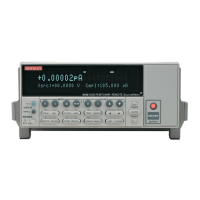Ohms Measurements 4-7
Offset-compensated ohms
The presence of thermal EMFs (V
EMF
) can adversely affect low-resistance measurement
accuracy. To overcome these unwanted offset voltages, use the offset-compensated ohms mea-
surement method.
In general, this method measures resistance (V/I) at a specific source level and then subtracts
a resistance measurement made with the source set to zero. With the source set to zero, the
source level is V
EMF
. Thus, the resistance contributed by the presence of V
EMF
is eliminated.
This two-point measurement method is mathematically expressed as:
Offset-Compensated Ω = ∆V / ∆I where ∆V = V2 – V1 and ∆I = I2 – I1.
V1 is the voltage measurement with the source set to a specific level.
V2 is the voltage measurement with the source set to zero.
I1 is the current measurement with the source set to a specific level.
I2 is the current measurement with the source set to zero.
For auto ohms, the SourceMeter will select the appropriate current source level and voltage
measurement range. For manual ohms, first select the appropriate source (V or I) value while
the output is off. When the source is turned on, the output will cycle between the programmed
value and zero (0A or 0V) to derive the offset-compensated ohms measurement.
NOTE Manual offset-compensated ohms is also available as a math (FCTN) operation.
This math function allows you to specify both source values. For details, see
Section 7, “Offset-compensated Ω.”
Measuring high resistance devices
When using offset-compensated ohms to measure high resistance values, an appropriate
source delay must be used to provide settled readings. There is a rise time associated with high
ohms measurements. For normal ohms measurements, you can watch the reading change on
the display. When it stops changing, you know you have the final, settled reading. For offset-
compensated ohms, this process is not as straight forward since the source is constantly chang-
ing between two values. If measurements are performed while the source is still rising (or fall-
ing), incorrect offset-compensated ohms readings will result. Therefore, it is imperative that an
adequate source delay be used to make sure that measurements occur while the source is at its
final, settled values.
Settling times are drastically different from one type of resistor to another. Another factor
that affects settling time is the test setup (i.e., cabling, fixturing, and guarding). These variables
make it necessary for the user to characterize his test system to assure that the source delay is
adequate.
NOTE Source delay is set from the source configuration menu (press CONFIG > select
SOURCE I (or V) > select DELAY). See “Source delay” in Section 3 for details.

